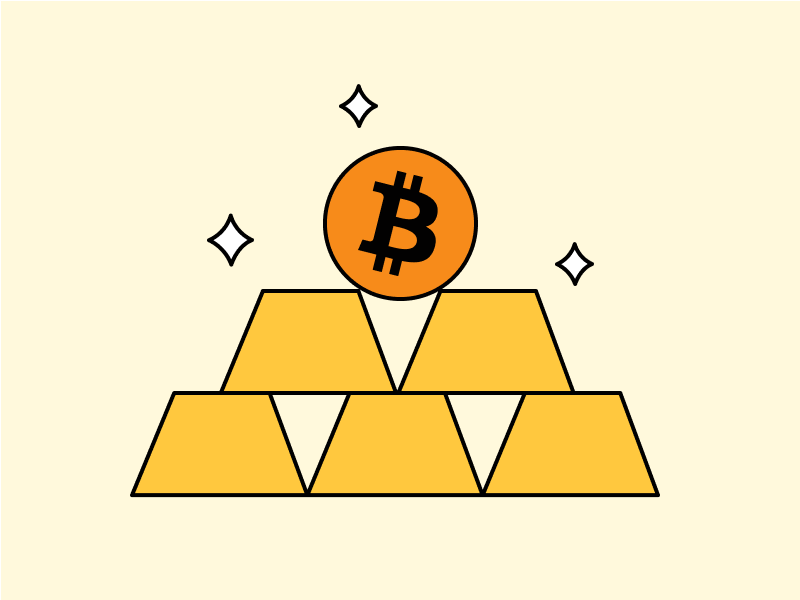Gold prices have soared since 2022. From mid‑2022 onward, gold has gained over 100%. Many factors drive price action, one being increasingly uncertain economic conditions. With physical gold harder to acquire, alternative options have emerged—one of which is gold-backed cryptocurrencies. So, what is gold‑backed crypto? What is the difference from physical gold? We’ll cover it in detail.
Article Summary
- 🥇 Gold-backed crypto is a digital asset pegged to the price of gold and fully backed by physical gold.
- ⛓️ These assets operate on blockchain technology, typically as ERC-20 tokens. It makes transactions easier and can be fractionalized so investors can have small gold holdings.
- 🟢 The advantages of gold-backed crypto are price stability, hedging against inflation, and higher transactionality compared to physical gold.
- 🔴 While it offers many advantages, gold-backed crypto also has disadvantages, such as relatively low liquidity and issues regarding the transparency and security of the physical gold storage that serves as collateral.
What is Gold-Backed Crypto?
Gold-backed crypto is a digital derivative asset whose value is pegged to the price of physical gold. This means that the asset’s value will closely track the fluctuations in the price of physical gold in the market. So, by making gold the underlying asset, every unit in circulation must have the same amount of actual physical gold stored in a custodian.
Gold‑backed crypto is a type of cryptocurrency whose price is tied to a physical gold asset and whose value is guaranteed by actual gold reserves. In practice, each token in circulation must be fully backed by physical gold held in custody.
The purpose of creating gold‑backed crypto is to bring a traditional investment asset like gold onto a blockchain, opening access to digital investors. As demand for gold continues to grow, tokenized gold assets become an attractive alternative.
With digital gold‑backed tokens, investors no longer worry about storage or management fees associated with physical gold.
How Gold-Backed Crypto Works
Gold-backed crypto works by tokenizing ownership of physical gold, and then the transaction will be stored on a blockchain. Tokens on the blockchain represent ownership of physical gold managed by the issuer. Meanwhile, the physical gold used as the underlying will be stored by the custodian, a bank, or a third-party institution.
The ratio used between assets and physical gold can vary in gold-backed crypto assets. Some use a 1:1 ratio (1 token equals 1 troy ounce of gold) or smaller fractions. Generally, gold-backed crypto tokens are ERC-20 standard tokens. This means they can be traded, sent, and stored in wallets supporting ERC-20 tokens.
Technically, gold-backed crypto is another variant of stablecoins. This is because stablecoins are crypto assets whose value is pegged to a stable, real-world asset. Typically, stablecoins are pegged to fiat currencies, such as USDC (pegged to the US dollar) or IDRT (pegged to the rupiah).
You can learn more about stablecoins and how they work in the following article.
Investors must buy in predetermined units of physical gold, such as 1 gram or 1 troy ounce. While in gold-backed crypto, investors can buy it with a much smaller nominal. Investors can make these purchases through exchanges that sell gold-backed crypto assets.
Some gold-backed crypto issuers offer a redemption feature where investors can switch their tokens into physical gold. If the investor decides to redeem it, the issuer will burn and remove it from circulation according to the number of tokens exchanged.
List of Gold-Backed Crypto
According to CoinMarketCap data, the total market cap of gold‑backed crypto assets is currently $1.7 billion, following gold’s increasing market size. As of April 21, 2025, gold trades at $109,000 per kilogram. Since late 2023, gold has broken its previous ATH and continued its parabolic trend.
1. PAX Gold

PAX Gold (PAXG) is a gold‑backed crypto issued by Paxos Trust Company. It uses physical gold from the London Bullion Market Association (LBMA) with a 1:1 ratio. So, 1 PAXG equals one troy ounce (400 g) of LBMA gold.
All gold backing PAXG is stored in LBMA vaults and audited monthly to ensure the number of PAXG tokens in circulation matches the gold held. Investor‑purchased gold is stored by Paxos’s custodian. Another feature is the ability to redeem PAXG tokens for LBMA gold.
As an ERC‑20 token, PAXG can be bought on various exchanges. Direct purchases on Paxos.com require a minimum of 0.01 PAXG. Pax Gold does not charge custodial or storage fees but charges a 0.02% transaction fee plus standard gas fees for transfers.
PAX Gold is currently the second‑largest gold‑backed crypto by market cap. PAXG has a market cap of $791 million, the highest among its peers, nearly doubling over the past year.
2. Tether Gold

Tether Gold (XAUt) is a gold‑backed crypto issued and controlled by TG Commodities Limited—a subsidiary of Tether. So, similar to PAX Gold, XAUt uses a 1:1 ratio, meaning 1 XAUt equals 1 troy ounce of LBMA gold. All LBMA gold backing XAUt is stored in Swiss vaults.
XAUt is an ERC‑20 token, tradable on exchanges, divisible down to six decimal places (0.000001 troy ounce). Direct purchases through Tether Gold require a minimum of 50 XAUt (50 troy ounces).
Users can redeem XAUt tokens for LBMA gold. Furthermore, Tether Gold charges no transaction fees beyond blockchain gas fees and it only applies a 25 basis‑point fee on purchases or redemptions.
XAUt’s market cap is $857 million, slightly above PAX Gold, making it the largest gold‑backed crypto asset. Its market cap has grown by about 80%, reflecting strong investor demand for crypto‑backed gold.
Pros of Gold-Backed Crypto
- 🥇 Price Stability: The primary advantage of gold‑backed crypto is that its value is pegged to gold. Therefore, its price remains stable, following gold’s market movements even when most other crypto assets decline.
- 💰 Low Barrier to Entry: Crypto‑backed gold has a much lower minimum purchase compared to physical gold, making it ideal for investors who want to invest incrementally in small amounts.
- 🛡️ High Liquidity: Unlike the past, gold‑backed crypto now has high liquidity and trading volume, comparable to major altcoins.
- 💲Low Costs: Buying gold as a crypto asset eliminates additional costs like management and storage fees.
You can find out information about the liquidity and transparency of a token through tokenomics. The following article will help you understand how to use tokenomics.
Comparison: Gold‑Backed Crypto vs. Physical Gold
| Indicator | Physical Gold | Crypto‑Backed Gold |
|---|---|---|
| Storage | Requires special storage and is vulnerable to theft if stored privately. | CEX or DEX wallet. |
| Transaction Fees | Depends on the seller. | No special transaction fees except for spread and blockchain transaction fees. |
| Accessibility | Does not require special storage; it depends on purchasing through DEX or CEX. | Buying and selling can be done in seconds. |
| Security | Secure if stored via a reputable third party. | Security depends on the underlying project. |
Risks of Crypto‑Backed Digital Gold
The main risk in buying and holding crypto‑backed digital gold comes from the project and asset you choose. Tether Gold and Paxos Gold are the two largest crypto gold projects, but they are relatively new. Their credibility and security are yet to be proved, unlike traditional gold institutions that have existed for decades.
There is also risk from the crypto platform you choose. Only buy crypto assets from certified CEX platforms like Pintu.
Conclusion
Gold-backed crypto is a digital asset that mirrors the price of physical gold, which can offer investors price stability and exposure to gold. As a subtype of stablecoins, gold-backed crypto presents numerous advantages, including price stability, protection against inflation, and improved transactional efficiency when compared to physical gold.
However, there are also some drawbacks. These include limited testing, relatively low liquidity, and transparency concerns related to the storage of physical gold as collateral. As of April 2023, the market capitalization of these assets has surpassed the $1 billion threshold, featuring popular options like PAX Gold and Tether Gold. Despite its potential, the broader adoption of gold-backed crypto and the establishment of investor trust are challenges that lie ahead.
How to Buy Gold-Backed Crypto on Pintu
For those of you who are interested in buying gold-backed crypto, there is no need to worry. You can buy one of the tokens, PAXG, on Pintu. The following is how to buy gold-backed crypto PAXG on Pintu:
- Create a Pintu account and follow the process of verifying your identity to start trading.
- On the homepage, click the deposit button and top up the Pintu balance using your preferred payment method.
- Go to the market page and look for PAXG.
- Click buy and fill in the amount you want.
- Now you have PAXG as an asset!
You can safely and conveniently purchase other cryptocurrencies such as BTC, ETH, SOL, and others safely and easily on Pintu. Pintu diligently evaluates all its crypto assets, highlighting the significance of being cautious.
Pintu is also compatible with popular wallets such as Metamask to facilitate your transactions. Download Pintu app on Play Store and App Store! Pintu is a fully regulated exchange certified by OJK and CFX.
Aside from buying and trading crypto assets, you can expand your knowledge about cryptocurrencies through various Pintu Academy articles. All Pintu Academy articles are for knowledge and educational purposes, not as financial advice.
Reference
- Krisztian Sandor, Tokenized Gold Surpasses $1B in Market Cap as Physical Asset Nears All-Time Price High, CoinDesk, diakses pada 19 September 2023.
- Marcel Deer, What is a gold-backed token and how does it work? Coin Telegraph, diakses pada 19 September 2023.
- Alexandria, Gold-Backed Cryptocurrency, CoinMarketCap, diakses pada 19 September 2023.
- XAUt Whitepaper, Tether Gold – A Digital Token Backed by Physical Gold, diakses pada 19 September 2023.
- Charles Cascarilla, Pax Gold Whitepaper, diakses pada 19 September 2023.
